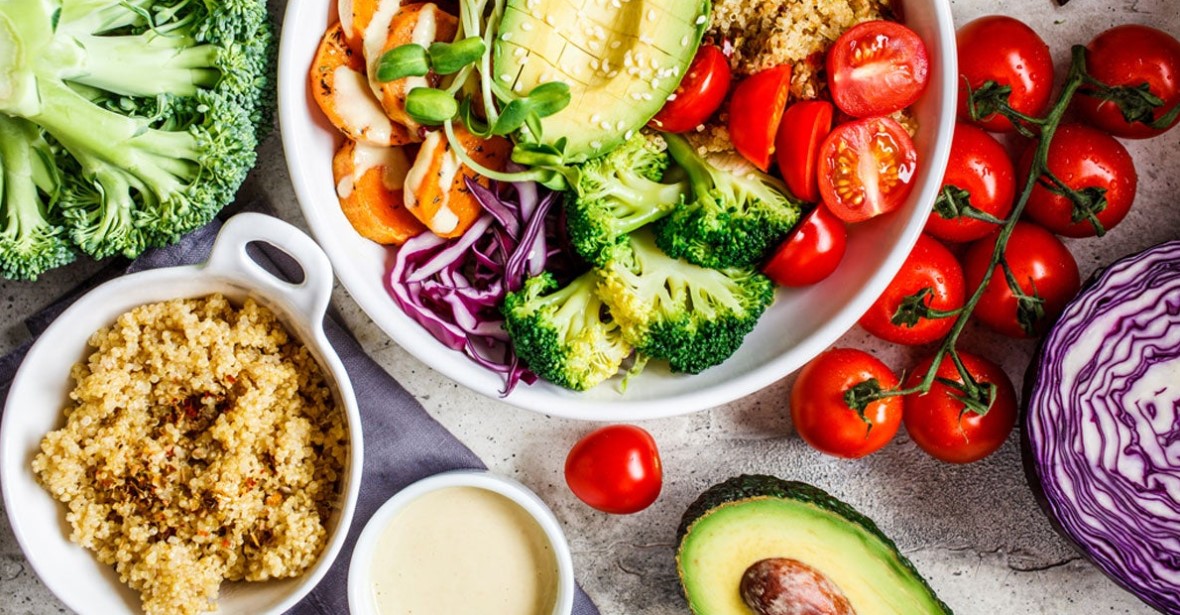Clean Eating Food List:
How can I improve my diet? Perhaps you don't really know how to eat cleanly. We have everything you need to achieve the perfect weight and calorie intake for you. Here's a great cleanse meal prep and shopping guide.
Clean eating is a dietary approach that involves consuming whole, minimally processed foods while avoiding refined and highly processed foods. The goal is to nourish the body with nutrient-dense foods while minimizing the intake of artificial additives and preservatives. Here is a list of what to eat and what to avoid on a clean eating diet:
What to eat:
Fruits: Apples, bananas, berries, oranges, grapes, etc.
Vegetables: Leafy greens, broccoli, cauliflower, carrots, peppers, etc.
Whole grains: Brown rice, quinoa, whole wheat bread, oats, etc.
Lean protein: Chicken, turkey, fish, tofu, beans, lentils, etc.
Nuts and seeds: Almonds, walnuts, chia seeds, flaxseeds, etc.
Healthy fats: Avocado, olive oil, coconut oil, nuts, seeds, etc.
Water: Stay hydrated by drinking at least 8-10 glasses of water per day.
What to avoid:
Processed foods: Foods that are high in sugar, salt, and fat, such as candy, soda, chips, and fast food.
Refined grains: White bread, pasta, and rice, which have been stripped of their nutrients.
Artificial additives: Preservatives, colors, and flavors added to processed foods.
Saturated and trans fats: Found in high-fat meats, fried foods, and processed snacks.
High-sugar foods: Foods that contain added sugars, such as desserts, pastries, and sweetened beverages.
Alcohol: Limit consumption of alcohol, or avoid it altogether.
Remember, clean eating is not about deprivation or extreme dieting. It's about making healthy choices that nourish your body and support your overall health and well-being.
Clean eating guidelines
Clean eating diets can also be more flexible than other diets. It's not taking long to eliminate a variety of foods that fit your lifestyle perfectly. Some people have to abandon the processed food and some do not have the same restrictions as others.
Here are some basic guidelines on how you can lead an effective health lifestyle. I'll be posting more about my Butcherbox reviews here. In addition, I utilize Thrivemarket to stock my freezer with organic canned foods and convenience goods. See Thrive Market Reviews.
Clean Eating for Beginners
Learning to eat a clean eating lifestyle can be easy. Please follow these suggested guidelines to help you determine which foods will be best suited for a clean eating diet. For optimal nutrient and calorie consumption, monitor your daily intake and maintain a balanced diet.
Eat Less Meat
Researchers say the elimination of processed foods has a positive health impact on your health. Veganism is not necessary for eating healthy, but eating less meat will help you decrease the risk of heart attacks as well as help control weight gain.
A diet of more plant products will increase your intake of vitamins and nutrients as well as fiber and fat. If you want to reduce the consumption of meat—the protein should not be a problem. American women get about 46 grams of protein a day in the form of dietary fat.
Load Up On Fruits and Vegetables
In our daily lives, we don't have enough vegetables to eat. Almost 10 million American citizens a day have at least one serving of vegetables a day. Eating less fruits and vegetables helps decrease the chance you have type-2 diabetes, heart disease, obesity, and cancer.
It also helps your gut to keep your micro-biome thriving and helps prevent autoimmune disease and even improve your mood.
Avoid processed foods
Process-food items can be easily identified by being found in containers. Often these products contain high sugar salts, low fat fiber grains and high saturated fat (including terrible trans fat).
Processing products include snack foods (fruit snacks or chip), candy ice cream, cookie ice full fat yogurt and cream, frozen meal salad dressing, bottled salad dressing, granulated soup ice cream. If you are looking to buy something in store you could always make it yourself with whole ingredients. The body would appreciate that.
Eat whole foods
Whole food is food without modification or manipulation. Because all the food has not been processed or refined, it does not contain artificial flavors or preservatives. Whole food includes fresh fruits and vegetables, low-fat proteins, nut or whole grains milk, whole grains, and dried beans/legumes. Unrefined food contains more nutritional fibre that is essential to our daily lives. Make your food better.
Healthy Fats
Fat can be eaten as added ingredients such food oils, salad dressings,, breads or dipping sauces. This can still be found in many foods, including protein. Most healthful fats tend to come from plants and can be found in whole foods packed with other important nutrients. How should one manage calorie consumption in order to reach fitness goals? Here's a good list of fats for your diet:
Read the nutrition labels
When eating clean for novices, you need some knowledge about the nutritional information on the food label that you plan on eating. Find the labels that have relatively few ingredients and think about the ingredient as the ingredient that would be used in preparing food?
If no, go ahead. Keep an eye on and avoid foods labeled with terms such as “hydrolyzing,” “modifying” or “processing. Find label containing the words “wholes grain” or whole grain bread or wheat in the ingredients.
Limit added fat, salt, and sugars
When choosing a diet that uses a natural and pure diet it is natural for you to choose organic foods, without artificial additives. Fruit can provide sugar if you want an easy, clean diet. If you eat wholesome food the less it will taste as sweet as it is salty. You are used to eating foods that contain additives that taste too good to eat.
Clean eating recipes
This can be an inexpensive and easy recipe for healthy eating. I have listed basic recipes for quick and easy recipes. All recipes also include recipes for preparing the meal and can be made at home every Sunday to provide healthy meals the whole week long.
Clean eating meal plan
How can one keep a healthy weight by focusing on clean eating meals and healthy food? Download a free four-week clean meal plan that includes a clean eating grocery list as well as a jumpstart weight reduction strategy.
Eat 5-6 meals per day
Don't think calorie counts are necessary. This calorie-count plan does not include any calories for each meal. It is time to count calories. Make conscious choices about what you eat like lean protein, carbohydrates and fats, fresh fruits.
A clean diet generally contains 1-2 small meals and two to three large snacks daily. Eating this way helps reduce overeating and the likelihood of having trouble metabolizing blood sugars. This helps with your weight loss.
What's considered clean eating?
Having an adequate clean eating plan includes eating whole fruit or vegetables, protein rich grains and healthy oils. This could also be associated with terms such as plants and grasses or sugar or gluten-free.
What is considered clean eating?
A clean diet may be full of more fresh fruit and vegetables, whole grains, or dietary supplements with fewer calories and fewer sugars or salt. It is often also referred to by words such as plant-based, grassfed, sugar and gluten-free.
Can you lose weight with clean eating?
Clean food is about eating food with minimal processing as far as the food is possible. Changing your diet can make reducing your weight easier for the healthiest person on the planet.
What is 10 days of clean eating?
Ensure you eat one to four clean meals a day a day. Take in whole unrefined food and drink water as needed. Its so easy.
How do I start clean eating for beginners?
How do you start eating healthy foods? Reduce processed food. ... Reduce refined sugars too. ... Bring some vegetables. ... Eat fruits at home. ... Eating healthy food. ... Consuming protein. ... Say "not" for salt shakers. '.. Observe the size of your portion.
What kind of food is clean food?
Whole foods such as fruits / veggies are a good choice. Generally, clean-eating packaged foods are more efficient and have minimal ingredients lists allowing easy access. Eat food with healthy ingredients like whole grains and nutritious oils.
What does eating clean do to your body?
Having a clean diet will keep you feeling and performing as good as ever. If you've had too high satiety or cholesterol before going clean, it can cause you to lower your cholesterol. Your bones and blood sugars are going higher.
What is a good clean diet?
It is important for everyone to have a clean and healthy diet. Use raw, unpackaged food instead of packaging. Think whole turkey instead of frozen turkey meatballs.
What is meant by clean eating?
Clean foods include whole fruits and vegetables, lean proteins, whole grains and healthy fats. Alternatively this word healthier foods can also refer to terms like plant-based, grassfed, gluten-free and sugar-free.
What foods are considered clean eating?
The following items show examples of how to clean diets: Frisch fruits. Including apples and pears. Vegetable. ... Lean meat and protein. The epoch was the beginning of a period of change, and was in the late 1960s, when the United States Congress took office. Grains (Cream food). ... Dairies. Fruits. Yeasts and fruits of apples, banana. Vegetable. ... Least weight foods. ... Food grains. ... Milks.
Why is it called clean eating?
It started out with good intentions: it meant eating many whole foods including fruits, vegetables fatty fish, whole grains, animal and vegetable protein nuts, seed oils and other foods. The idea was to only eat foods closest to nature.
Are eggs considered clean eating?
Clean cooking should not be as complicated as it should be. Clean food at breakfast can be found in eggs, dairy products or wholesome grains.
What happens to your body when you start eating clean?
Clean meals provide a rich source of healthy fats and nutrients that boost cardiovascular and brain health.
What is the best way to eat clean?
Seven principles for a clean diet. Select wholesome foods and avoid highly processed foods.. ... Pick a simple food over refined food. ' ". Give each of the meals protein, carbs and fats. ... Be cautious about calories.
What are the advantages of eating natural foods?
Why is eating healthy good for your health? This can prolong the life. Keeps the skin clean. Supporting muscles. Increases immune system strength. Stimulates bone structure. Increasing the risk of cardiovascular disease, Type 1 diabetics and other forms of cancer is helpful.
Support pregnant women to have healthy children in pregnancy. Helping digestive functions. It improves the quality of life. Ensures good skin growth. Support the muscle. Increases immune capacity. Strengthening bones. Lower risk of cardiovascular and other chronic diseases, as well as cancer if not treated early. Supports pregnancy health. Supports breastfeeding. Aid digestion.
What is natural food called?
Natural foods do not have additives. Healthy foods refers to foods that have undergone minimal processing like granular flour brown rice sweet potatoes.
What is a clean healthy diet?
The ideal healthy food should contain healthy fats, such as whole fruits refined grains and vegetables. Often this term has the meaning plant-based grass-fed sugar-free, gluten-free.
What can you not eat when clean eating?
Food to avoid: Food processed too much. Especially white sugars. Artificial sweeteners. Sugary drinks. A Drink. Foods containing chemicals – dyes and sodiumnitrites for example. Food made with preservatives.
Artificial products like processed cheese slices. Saturates fats – trans fats. Overprocessed food, and refined carbs, particularly white flours and glucose. Artificial sweetness. Sugary drinks, including soda and juices. Alcoholism. Agricultural foods containing chemical additives. Food made from preservatives. Artificial food, including cheese Saturated oils versus lipids.
What are the basics of clean eating?
Seven Principles for a Healthy Lifestyle. Choose pure, natural food and try eliminating or minimising the processed foods. ... Choose simple food to avoid the greasy taste. ... Include protein, carbohydrates or calories in each meal. ...
Be careful of the fat and salt. ...... Eat 5-6 small meals daily. ... Keep drinking calories! Select whole-food products and avoid processed products. ... Choose raw food instead of processed foods. / / > Make sure you have plenty of protein, carbohydrates, and fat in your diet each day. ... Be careful about calories, salt or added sugar too. ... Take 5 to 6 small foods each day. ... Do not eat calories.
What is the cleanest possible diet?
Whole foods are often an attractive option. Minimally processed foods can easily fit into healthy eating diets. Select foods with healthy nutrients, including whole foods and nutritious fats.
Do you lose weight on Whole30?
Nevertheless, most Whole30ers lose a little weight after they try this program. Using Whole30 helps people consume foods that have been sourced from nature and are naturally occurring.
What happens to your body when you eat only whole foods?
Generally, eating wholesome foods lowers your risk of heart disease and vascular disease. Whole foods are generally low in carbohydrates and high in fiber, which helps maintain a healthy blood glucose.
What is considered a clean diet?
In general, a clean diet includes fruits processed grains and vegetables-based protein foods containing whole grains and healthy fat. It may include the terms plant-based, grass-fed, sugar-free or gluten-free.
What is clean living eating?
Clean foods are usually made from fresh and ripe fruits raw nuts and vegetables, high fiber whole grains, low salt foods, low sugar. This could be linked to terms including plant - or grain based, sugar based and gluten-free.
Are eggs allowed on the clean diet?
Eggs have great nutritional value. It’s good to have legumes as a protein source. Keep looking for low-sodium alternatives when feasible.
What are examples of unprocessed foods?
Food that is natural form not processed This enables the food to stay stored longer. Often fresh fruits, vegetables more fruits, whole grain nuts and milk fall under these categories.
What can I eat for breakfast that is not processed?
Food options. Various fruits and vegetables varieties. Dry fruits, fresh fruits, seeds. Butters like peanuts, almonds, nutritional yeast. Milks, yogurt, dairy, and yogurt from plants. A baked bean, a sprout, legumes and.
Suitable for the consumption of: organic produce products. A variety of berries, fruits and vegetables. Dry fruit, dried berries, seeds etc. Nuts such as almond butter or peanut butter, nutritional yeast. Milk, yogurts, plant milk, or fruit juice yoghurt. Soaked bean sprouts. Natural and non-processed food -
How can I eat less processed foods on a budget?
What is healthy food? Make shopping easier. Fruit and vegetable stores and local supermarkets and butchers can make great stores for whole foods and can often be cheaper too. = = = = = = = Make checks on the labels. ... Prepare dinner at the house. ... Snacks for all the food. ... Make it real.







































































































































